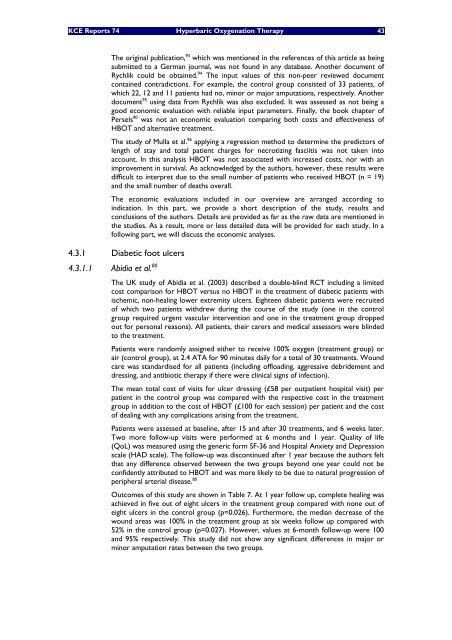Hyperbare Zuurstoftherapie: Rapid Assessment - KCE
Hyperbare Zuurstoftherapie: Rapid Assessment - KCE
Hyperbare Zuurstoftherapie: Rapid Assessment - KCE
Create successful ePaper yourself
Turn your PDF publications into a flip-book with our unique Google optimized e-Paper software.
<strong>KCE</strong> Reports 74 Hyperbaric Oxygenation Therapy 43<br />
The original publication, 93 which was mentioned in the references of this article as being<br />
submitted to a German journal, was not found in any database. Another document of<br />
Rychlik could be obtained. 94 The input values of this non-peer reviewed document<br />
contained contradictions. For example, the control group consisted of 33 patients, of<br />
which 22, 12 and 11 patients had no, minor or major amputations, respectively. Another<br />
document 95 using data from Rychlik was also excluded. It was assessed as not being a<br />
good economic evaluation with reliable input parameters. Finally, the book chapter of<br />
Persels 90 was not an economic evaluation comparing both costs and effectiveness of<br />
HBOT and alternative treatment.<br />
The study of Mulla et al. 96 applying a regression method to determine the predictors of<br />
length of stay and total patient charges for necrotizing fasciitis was not taken into<br />
account. In this analysis HBOT was not associated with increased costs, nor with an<br />
improvement in survival. As acknowledged by the authors, however, these results were<br />
difficult to interpret due to the small number of patients who received HBOT (n = 19)<br />
and the small number of deaths overall.<br />
The economic evaluations included in our overview are arranged according to<br />
indication. In this part, we provide a short description of the study, results and<br />
conclusions of the authors. Details are provided as far as the raw data are mentioned in<br />
the studies. As a result, more or less detailed data will be provided for each study. In a<br />
following part, we will discuss the economic analyses.<br />
4.3.1 Diabetic foot ulcers<br />
4.3.1.1 Abidia et al. 80<br />
The UK study of Abidia et al. (2003) described a double-blind RCT including a limited<br />
cost comparison for HBOT versus no HBOT in the treatment of diabetic patients with<br />
ischemic, non-healing lower extremity ulcers. Eighteen diabetic patients were recruited<br />
of which two patients withdrew during the course of the study (one in the control<br />
group required urgent vascular intervention and one in the treatment group dropped<br />
out for personal reasons). All patients, their carers and medical assessors were blinded<br />
to the treatment.<br />
Patients were randomly assigned either to receive 100% oxygen (treatment group) or<br />
air (control group), at 2.4 ATA for 90 minutes daily for a total of 30 treatments. Wound<br />
care was standardised for all patients (including offloading, aggressive debridement and<br />
dressing, and antibiotic therapy if there were clinical signs of infection).<br />
The mean total cost of visits for ulcer dressing (£58 per outpatient hospital visit) per<br />
patient in the control group was compared with the respective cost in the treatment<br />
group in addition to the cost of HBOT (£100 for each session) per patient and the cost<br />
of dealing with any complications arising from the treatment.<br />
Patients were assessed at baseline, after 15 and after 30 treatments, and 6 weeks later.<br />
Two more follow-up visits were performed at 6 months and 1 year. Quality of life<br />
(QoL) was measured using the generic form SF-36 and Hospital Anxiety and Depression<br />
scale (HAD scale). The follow-up was discontinued after 1 year because the authors felt<br />
that any difference observed between the two groups beyond one year could not be<br />
confidently attributed to HBOT and was more likely to be due to natural progression of<br />
peripheral arterial disease. 80<br />
Outcomes of this study are shown in Table 7. At 1 year follow up, complete healing was<br />
achieved in five out of eight ulcers in the treatment group compared with none out of<br />
eight ulcers in the control group (p=0.026). Furthermore, the median decrease of the<br />
wound areas was 100% in the treatment group at six weeks follow up compared with<br />
52% in the control group (p=0.027). However, values at 6-month follow-up were 100<br />
and 95% respectively. This study did not show any significant differences in major or<br />
minor amputation rates between the two groups.

















